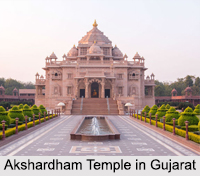 Akshardham Temple in Gandhinagar, Gujarat is an inimitable cultural complex built in the honour of Lord Swaminarayan. Inspired by H.D. Pramukh Swami Maharaj, and his organisation Bochasanwasi Akshar-Purushottam Swaminarayan Sanstha (BAPS) of India, Akshardham is the successful end product of unquestionable service and devotion of thousands of volunteers. The entire monument was built without the use of steel. Besides a 7 feet gold leafed idol of Lord Swaminarayan and his holy ruins, there are three exhibitions on Indian culture with light and sound shows. Akshardham Swaminarayan Temple opened its doors to visitors on 2nd November 1992. The inaugural ceremony coincided with the centenary celebrations of Yogiji Maharaj and was conducted by Pramukh Swami Maharaj himself.
Akshardham Temple in Gandhinagar, Gujarat is an inimitable cultural complex built in the honour of Lord Swaminarayan. Inspired by H.D. Pramukh Swami Maharaj, and his organisation Bochasanwasi Akshar-Purushottam Swaminarayan Sanstha (BAPS) of India, Akshardham is the successful end product of unquestionable service and devotion of thousands of volunteers. The entire monument was built without the use of steel. Besides a 7 feet gold leafed idol of Lord Swaminarayan and his holy ruins, there are three exhibitions on Indian culture with light and sound shows. Akshardham Swaminarayan Temple opened its doors to visitors on 2nd November 1992. The inaugural ceremony coincided with the centenary celebrations of Yogiji Maharaj and was conducted by Pramukh Swami Maharaj himself.
Structure of Akshardham Temple
Six thousand tons of pink sandstone, used in the construction of the temple, did not go unnoticed; it stands tall at a height of 108 feet and is 240 feet long, 131 feet in breadth. The porch around the monument measures 1751 feet in length alone. The garden surrounding the sanctum sanctorum is known as Sahajanand Van and represents a unique intermingling of reflective garden and children`s park. A marble statue of Lord Swaminarayan is placed in the garden premises also.
Akshardham Centre for Applied Research in Social Harmony
The Akshardham temple complex has its own research centre, Akshardham Centre for Applied Research in Social Harmony (AARSH). The research facility has an extensive library, study stations and archives. However, it is only open to enlisted scholars who receive the benefits. The first floor of the temple has a museum, with a gallery of over 500 `parahansas`. The other items displayed are, the letter to Swaminarayan`s guru, Ramanand, an art object from an old tree from Chapaya, Swaminarayan`s used shawl and an image of the Lord seated on a horse. The exterior galleries serve as the venue for artistic exhibition and offer Chez Integrovision shows, audio-visuals, multi-media and the works of Lord Swaminarayan from the Hindu epics.
Exhibition Halls in Akshardham Temple
There are three permanent exhibition halls inside the complex, set up with the aim of educating masses on spiritual matters and BAPS movement:
 Hall 1 (Sahajanand) of Akshardham Temple: This hall hosts the Sahanand exhibition and uses imaginative props to illustrate the life of Lord Swaminarayan. The exhibition portrays `travel in time` through creative visualisation, a fibre-optics cosmos, miniature recreation of Chhapiya village, in addition to three `light-n-sound` shows, etc.
Hall 1 (Sahajanand) of Akshardham Temple: This hall hosts the Sahanand exhibition and uses imaginative props to illustrate the life of Lord Swaminarayan. The exhibition portrays `travel in time` through creative visualisation, a fibre-optics cosmos, miniature recreation of Chhapiya village, in addition to three `light-n-sound` shows, etc.
Hall 2 (Sat-Chit-Anand) of Akshardham Temple: This holds the Sat-Chit-Anand exhibition in a 14-screen multimedia representation. Apart from that, there is the `integrovision`, an elucidation of Vedic philosophy and of man`s search for the eternal truth, `Tunnel of Mirrors`, a glass mosaic and a dancing musical fountain.
Hall 3 (Nityanand) of Akshardham Temple: It has walk-through dioramas and fibre glass figurines portraying messages from the Upanishads, Ramayana and Mahabharata. An audio animatronics show, a re-created Hastinapur palace (Mahabharata), a re-created serene Gurukul, compositions of saint-poets and an exposition of `Harmony of world religions` are some of the other magnets of the exhibition.
Abhishek Mandapam in Akshardham Temple
The temple has an Abhishek Mandapam; it is an area designated for all visitors to perform abhishek on the murti of Neelkanth Varni - a yogic form of Swaminarayan. The murti of Neelkanth Varni was established in 2014 by Pramukh Swami and the Abhishek Mandapam was inaugurated on 14th December 2015 by Mahant Swami. The Abhishek ritual begins with the tying of a Kalava on the visitor`s wrist along with the recitation of Hindu shlokas. This Kalava is a sacred thread for Hindus.





















